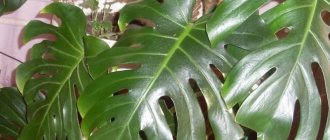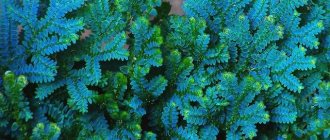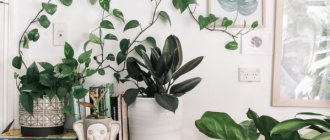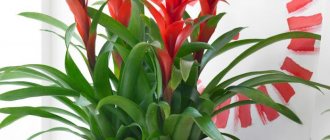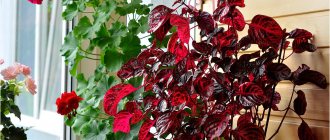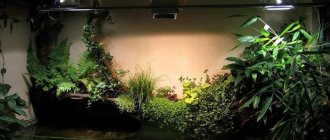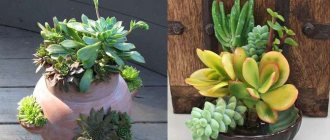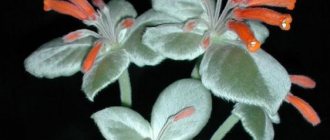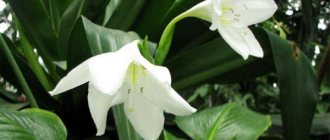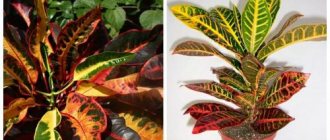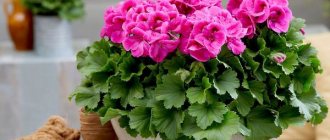The most unpretentious indoor flowers
A green corner does not necessarily mean a lot of new troubles and a waste of time. There are many completely unpretentious flowers that require your minimal participation.
Ficus
At the head of unpretentious and universal plants for the home is unconditionally the ficus with all the variety of its varieties. There are compact species up to 20 cm, and there are full-fledged trees that stretch several meters.
Aspidistra
Aspidistra became a regular guest in offices precisely because of her unpretentiousness. For decorative leaves, weekly watering is enough so that the temperature around does not fluctuate more than 3-5 degrees.
Aloe
Healing aloe is widely used in pharmaceuticals, cosmetology and hundreds of folk recipes. It is infinitely unpretentious on the windowsill, because the fleshy leaves independently store moisture and nutrients.
Aglaonema
Aglaonema is afraid of direct sunlight, so it is ideal for remote and shady corners. Decorative variegated species differ in color, up to rare red-pink.
Fuchsia
Beautiful decorative fuchsia can be easily grown at home on a windowsill, especially since in winter it just likes cool weather. In summer, the flower can be taken to the country and transplanted into a container.
Asparagus
Beautiful and unusual asparagus with needle-like leaves requires periodic watering and annual replanting. Otherwise, it does not need any special conditions and any lighting is suitable.
Balsam
Although impatiens are called impatiens, the small bush is completely unpretentious to care for. Partial shade and plenty of watering are enough for him, but he is completely indifferent to dry air.
Schlumberger
Few plants can be proud of such an abundance of names - “schlumbergera”, “zygocactus”, “zygocereus”, “Rozhdestvennik”, “varvarin flower”. It is also called “Decembrist”; the plant’s popular names hint at the time the flowers appear - the second half of December, closer to St. Barbara’s Day according to the Orthodox calendar and Catholic Christmas.
All varieties are succulents; they store moisture in the stems. The branches consist of segments with rounded or angular edges. The shoots are flat in shape, consist of separate segments, and have jagged edges. New segments grow from existing ones, and as they grow, the shoots bend in the shape of an arc. Buds appear at the ends of the shoots. The flowers are bright, multi-tiered, with a bunch of long stamens in the center.
Gertner
This popular houseplant features bright red-orange flowers borne on large, sturdy stems. Gertnera is a large bush with shoot segments reaching up to 7 cm. In appearance, the flowers resemble multi-tiered elongated bells. Widely bell-shaped flowers contain many narrow pointed petals, the diameter reaches 6 cm.
Buckley
This hybrid variety is characterized by multi-tiered flowers located at the ends of the shoots with protrusions along the edges. The height of the bush is 50-70 cm. Shiny dark green shoots, divided into separate segments, end in large tubular flowers, the petals of which are arranged in several tiers. Their size can reach up to 10 cm. This is an ampelous species, buds appear from November to March.
Pasadena
"Pasadena" is a very rare variety of Christmas tree. Its characteristic feature is elongated wavy leaves . The shoots, unlike other varieties, stretch upward. The flowering cannot be called lush and abundant, but the original appearance of the bush attracts many amateur gardeners. "Pasadena" decorates the apartment with spectacular multi-tiered red-purple flowers with wide petals.
Kris Kringle
Schlumberger's Kris Kringle is the choice of gardeners who have limited space to place pots. The bush is compact, the crown is moderately lush, the stem segments are short. Flowering continues for several months if the owner provides proper maintenance conditions, timely watering and fertilizing, the flowers and stems do not fade and retain their decorative effect throughout this time.
Climbing indoor flowers
Luxurious ivy and vines beautifully entwine walls, shelves or racks. You can grow quite a few different varieties and species in your room!
Monstera
Monstera is prized for its fancy and large carved leaves. It grows quickly and wraps around any support, attaching to it with thin aerial roots.
Cissus
Decorative cissus belongs to the grape variety and came to us from the islands. Special tendrils are firmly attached to the support, and the flower grows throughout the year - without pronounced dormant periods.
Tricolor morning glory
If morning glory grows in the garden for only a year, then in the room it is a lush flowering perennial with bright petals. It has rather large and heavy leaves, so it needs to be carefully tied to a support.
Wax ivy Hoya
The plant got its name from its unusual flower umbrellas, as if covered with wax. In order for ivy to grow more beautifully, it needs to be periodically replanted and tied up.
Stephanotis
The large vine reaches five meters in length and blooms with elegant fragrant flowers, for which it is also nicknamed Madagascar jasmine. The color of different varieties varies from soft cream to pale lilac.
Syngonium
Syngonium grows up to one and a half meters and clings tightly to the support. Among the variety of varieties, there are species with whitish, green or variegated leaves, which with age become lancet-lobed.
Dipladenia
Another climbing flowering guest from the tropics with large buds up to 10 cm in diameter. Dipladenia loves fresh air and open space, so in summer it can be taken to the balcony or street.
Olga Sobachkina
Nature is an artist, no matter what colors and shades are in her palette. We, taking advantage of her generosity, can create beautiful gardens, combining the colors, shapes and sizes we need. And to make it easier to navigate the world of natural colors, we decided to write several articles dedicated to “colored” plants. Today we will talk about plants of gray, silver and bluish tones.
If everything is clear with gray and silver shades, then not everyone can imagine what a bluish color is.
Gray color is a dark gray color with a bluish whitish tint. In plants, the bluish color is usually associated with the presence of phytochrome.
Wikipedia
Plants with a gray color add sophistication to flower beds and allow neighboring plantings to look brighter against their background. For classic-style gardens, grayish plants are used to add clean lines to flower beds and borders. As a rule, all plants with grayish foliage come from warm regions.
Perennial plants with silver, gray and bluish leaves
Feathery Hungarian carnation
An excellent ground cover plant with thin blue-gray leaves and pink flowers. Grows quickly and tolerates drought well. Great for borders, rockeries and adding color to flower beds. It looks gentle and noble.
Artichoke
A tall plant with large silvery, pinnately dissected leaves. Blooms with large purple inflorescences. Heat-loving and prefers sunny places. Doesn't like to change his place of residence. Suitable for rockeries, ridges, retaining walls. Many people call it a thorn.
Jaskolka Bieberstein
A creeping ground cover plant with small white flowers and gray leaves. Height is about 20 cm, grows into a hen with a diameter of 60 cm. Blooms in May and June. It can grow on dry and rocky soils, but prefers loose sandy ones. Tolerates lack of watering and is frost-resistant. Resistant to trampling.
Veronica gray
The plant is about 40 cm tall, with silver-gray felt leaves. It blooms very beautifully with lilac or blue flowers located on tall ears. After flowering it forms a lush low bush. Prefers rocky alkaline soils that are not waterlogged. Used in folk medicine.
Chistets Byzantine
A ground cover plant with oblong green leaves completely covered with white tall hair, which makes it look completely white from a distance. Attracts attention in flower beds, looks good as a border plant, decorates rockeries and rocky gardens. Does not require watering, prefers poor soils, tolerates shade, but not too much, as it can turn green in the shade. The flowers are formed on tall stems and have a lilac hue. Many people prefer to remove flower stalks, as they slightly spoil the decorative effect of the entire plant.
The choice of plants with silvery leaves is quite wide; in addition to those described above, these include rosemary, Santolina cypressum, rock alyssum, cineraria, some types of juveniles, tomentosa, groundsworts, some types of sedums, host varieties, oatmeal, alpine edelweiss, sages and other plants with fleecy leaves .
Shrubs with gray, bluish and silver leaves
Silver goof
This is a small shrub about 2 meters high with a beautiful rounded crown and hard silvery leaves. Prefers slightly acidic soils and sunny places. It blooms with small silver-yellow flowers and is a wonderful honey plant. It grows very well with root shoots. Tolerates drought. Eleven angustifolia also has silvery leaves, narrow and long. The size of the bush already reaches 5-6 meters.
Sea buckthorn
A low tree or shrub with small elongated silvery-green leaves. Prickly. The fruits are edible and very healthy. In addition, the bush with silver leaves and bright orange berries looks very elegant. In order for the plant to bear fruit, male and female sea buckthorn must grow on the site. Prefers to grow on sandy soils near water bodies.
Canadian blue spruce "Sanders Blue"
A very small spruce with bright silver-blue needles. Grows up to 1.5 m, may turn a little green with age. It grows very slowly. Loves sunny places, tolerates frosts. It’s better not to flood it, but to water it in the dry summer heat, as if from a shower.
Juniper scaly “Blue Star”
Juniper squamata has different forms: creeping, prostrate and tree-like. The Blue Star variety has a silver-blue color. In adulthood it reaches only 50 cm, with a crown diameter of about 1.5 meters. Adapts to different soils, but has difficulty tolerating dense ones. It is necessary to protect it from snowdrifts, as the crown may become deformed. Suffering from spring sunburn, it is better to choose a place for him where he will be protected from the sun during the day.
Among conifers, there are quite a few species with silvery needles. This includes, in addition to those already described, Canadian blue spruce and conical spruce, pea cypress and many varieties of juniper: virginian, rock (rather tall varieties), recumbent, Chinese, horizontal (creeping varieties).
To complement your arrangements with greyish-blue plants, also take a look at our collection of blue plants.
If you want to learn more about other ornamental but easy-to-use shrubs and trees, check out our Garden Plants Audio Guide. You can test it for free!
House project “Time to create gardens”
Tsyganova Oksana
And you may also be interested
in How to improve clay soil
How to save energy and time: drip irrigation
Indoor flowers that bloom all year round
If you want your home flower garden to delight you throughout the year, you can organize it! Decorative ever-flowering varieties are exactly what you need!
Abutilone
The beautiful abutilon is called indoor maple for its characteristic leaf shape. If you continue feeding and take care of lighting at the end of the season, it will bloom in winter.
Begonia
Begonia blooms all year long if the temperature around is above +16 degrees and it has enough light. Every two weeks, feed the flower and place a container of water around it to humidify the air.
Hibiscus
The beautiful evergreen hibiscus is nicknamed the Chinese rose for its beauty and elegance. It is quite demanding to care for and can drop all its buds if there is a lack of moisture.
Anthurium
Anthurium has not only beautiful flowers, but also large glossy leaves that resemble hearts. The plant requires moisture, spraying, fertilizing and heat - from +15 degrees.
Geranium
Unpretentious geraniums feel great on windowsills under any conditions. They don’t even need a very high temperature - +8 degrees is enough, but regular inflows of fresh air are required.
Koleriya
Kohleria attracts attention with its unusual bell-shaped flowers. It is undemanding in terms of lighting and watering, but requires high air humidity.
Balsam
In winter, balsam continues to bloom even under ordinary artificial lighting, for which flower growers value it. But he does not tolerate cramped spaces, so it is better to move the flowerpots away from neighbors.
Gray plants and flowers: the most beautiful for your garden!
Perennial
- Chistets Byzantine (lat. Stachys byzantina). People often call it “rabbit ears.” A small plant with a unique silvery sheen on the leaves. Blooms for a long time, throughout the summer. Height is about 15-20 cm.
- Gray fescue (lat. Festuca glauca) . An amazing plant with leaves 15 cm high and inflorescences 30 cm high. With proper care and timely pruning, it forms a dense and beautiful carpet. Flowering time is August.
- Alpine sheep (lat. Helictotrichon sempervirens) . Attracts attention with its elegant leaves and spikes that rise above other gray plants. The leaves are about 25-30 cm long, and the inflorescences are 60-70 cm. Flowering time is July-September.
Annuals
- Seaside cineraria (lat.Senecio cineraria) . This is one of the most silvery and gray flowers and plants on the planet. Silver foliage captivates at first sight. It has not entirely decorative inflorescences, small in height, 15-20 cm.
- Mealy sage (lat.Salvia farinacea Silber) . A favorite variety of many experienced gardeners for its high decorative qualities and unpretentiousness. It blooms intensely and beautifully for a long period of time (June-October). From 30 to 50 cm in height.
- Hairy dry grass (lat. Gnafalium obtusifolium) . Many people successfully grow it on balconies. Long and beautiful shoots overshadow the appearance of the inflorescences. Height – 8-12 cm.
- Schmidt's Wormwood (Artemisia schmidtiana Nana) and Tomentosa are worthy of special mention.
Indoor flowers for the bathroom
A green corner in the bathroom is a real dream, because it promotes pleasant relaxation after a hard day. Not all plants will withstand such conditions, but we found several options!
Dracaena Sandera
Due to the special shape of its shoots, Dracaena Sandera is called indoor bamboo. It looks wonderful solo in pots and in glass vases with water. Keep in mind that she needs more space, because she grows quickly.
Orchid
There is a stereotype that orchids are extremely capricious, but several of their varieties will fit perfectly into the bathroom. These are phalaenopsis and paphiopedilum, which require high humidity and soft diffused light.
Philodendron
This is a hanging indoor plant, which requires much more moisture than light. It needs constantly moist soil and more space - very soon you will get a whole green wall.
Calathea
Large decorative calathea leaves feel ideal even at 90% humidity. They need warmth without sudden temperature changes and fairly short glimpses of the sun.
Nephrolepis
Exalted nephrolepis is one of the varieties of ferns that is not afraid of moisture and loves regular spraying. But it needs sunlight, so if there is no window in the bathroom, you will have to periodically take out the flowerpot.
Chlorophytum
Delicate and graceful chlorophytum is one of the most unpretentious indoor flowers. He loves a lot of moisture, which is quite enough in the bathroom, and can live and grow in the shade.
Indoor pomegranate
Pomegranate is a subtropical plant suitable for growing as an ornamental houseplant. With proper care, it will not only bloom, but also bear fruit. It looks like a tree with numerous thin branches with thin thorns. The leaves are small, elongated, pointed at the ends.
The pomegranate flower has an unusual shape, it has a hard red perianth covering the inner petals, depending on the variety, yellow, white or bright scarlet..
Dwarf species suitable for growing at home:
- Ruby;
- Baby;
- Uzbekistan;
- Nana.
These varieties have a height of 50 to 100 cm. You can grow a seedling from a seed, but you will not be able to get good fruits, since hybrids are grown for sale. The main difference between dwarf varieties and garden varieties is that they do not shed their leaves for the winter. Pomegranate blooms for a long time, from April to the end of summer. The flowers look like bells or water lilies and are self-pollinating . After flowering, edible fruits are set.
